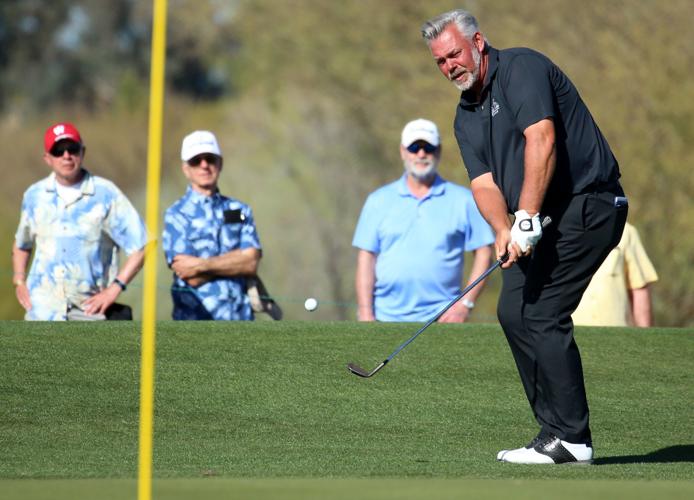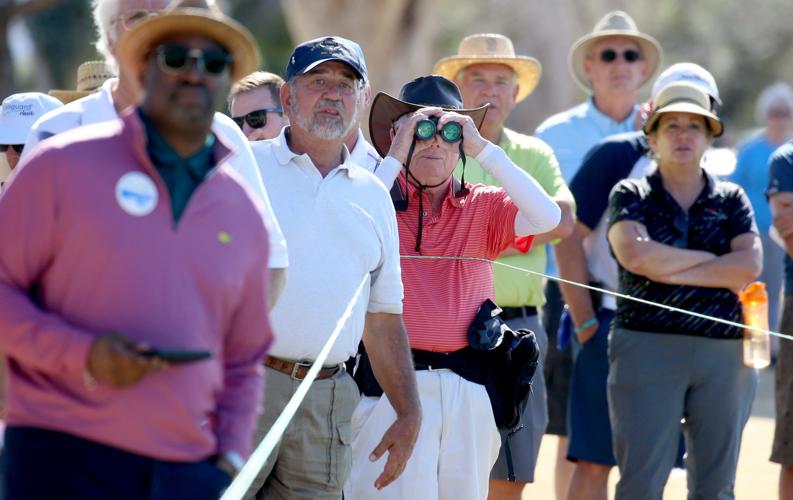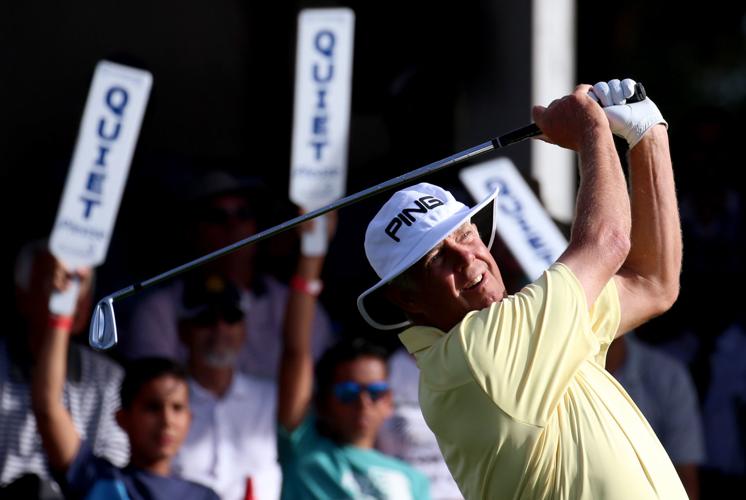A man who looks more like Ernest Hemingway than Ernest Hemingway looked like Ernest Hemingway made a 60-foot putt at the 18th green Sunday, igniting a roar reminiscent of Arnold Palmer winning at Tucson National in 1967 or Johnny Miller in 1975 or Phil Mickelson in 1995.
But the Hemingway look-alike, 2011 British Open champion Darren Clarke, merely finished in a tie for second Sunday at the Cologuard Classic. When 62-year-old Mark O’Meara drained a par putt 15 minutes later, the roar returned, sort of like an echo that bounced off Sombrero Peak and returned on cue to engulf Tucson’s historic golf course.
As sporting events in Tucson go, the Cologuard Classic was an A-plus. It had all four elements of success: (1) glorious weather; (2) a large, invigorating crowd; (3) a Cinderella story, with golf’s equivalent of a walk-on, Sabino High grad Willie Wood, finishing tied for second, and (4) a champion, Mark O’Meara, worthy of eight decades of Tucson Open predecessors.
At one point over the weekend, O’Meara drained eight consecutive birdie putts. He’s 62 years old. He hadn’t won since 2010. It was irresistible.
Nobody cried, but because O’Meara, a former Masters and British Open champ, is considered one of the class acts of pro golf, it might have set a golf record for warm and fuzzy feelings.
Rather than the typical congratulatory hand shake, O’Meara’s playing partners, Kirk Triplett and Scott McCarron, stood on the green and applauded. Have you ever seen that on the PGA Tour?
Just as the Conquistadores prepared a coronation, presenting O’Meara with a splendiferous 17th-century styled Spanish helmet, a very important man was led onto the 18th green.
Richard B. “Buck” O’Reilly is one of four surviving men from the original Conquistadores, the group that saved pro golf in Tucson 54 years ago. O’Reilly, a prominent Tucson automobile dealer, is one of the main reasons Mark O’Meara and Tiger Woods and Lee Trevino and Tom Watson, and now O’Meara, have worn the Conquistadores helmet since 1965.
“You don’t imagine something like this,” O’Reilly said. “You just do your best to get it right year after year.”
The confluence and ultimate partnership of the Conquistadores and Tucson National is one of the most compelling sports stories in Tucson history.
From 1945-64, the Tucson Open was a low-level PGA Tour event that paid peanuts and attracted a modest group of pro golfers. By 1962, it was in financial distress. A Tucson attorney, Fred Marquez, attempted to stop the event because, he said, it didn’t promote local golf and was nothing more than an elitist adventure at the struggling El Rio Country Club.
“We’re not putting another cent into this unless the PGA Tour guarantees us better players,” Marquez said.
Prize money was the lowest on the not-yet-flourishing PGA Tour, $25,000 a year, and it had no future at the much less than country-clubbish El Rio facility.
“We’ve got problems,” said Tucson Golf Association president Dr. Ed Updegraff, who went on to be the most accomplished amateur golfer in state history. “We’re having trouble getting a date for a 1963 tournament.”
About that time, Bill Nanini, a son of a wealthy Chicago construction magnate who had bought about 400 acres of land on an old cotton farm near today’s Tucson National property, played in the Pro-Am as part of the 1958 Palm Springs Open. Nanini noticed that golf courses in the Palm Springs area were being built in impressive numbers.
“I told my dad that our property in Tucson was better than the property in Palm Springs,” Bill Nanini told me in 2002. The Naninis hired Chicago golf course architect Robert Bruce Harris and plans for Tucson National began in 1959.
At the time, Tucson’s only golf courses were El Rio, Tucson Country Club and 18 holes at the downtown Randolph facility. What followed was Tucson’s golf equivalent of the California gold rush.
Oro Valley Country Club and Forty Niner Country Club were built. A new 18 holes at Randolph was planned. But it was Nanini’s facility in what was then the faraway northwest side of Tucson that turned heads.
The PGA Tour sent its assistant tournament manager, Jack Tuthill, to Tucson National in 1964, and he was properly impressed.
“This course should attract top pros,” he said. “Perhaps only El Dorado and Palm Springs compare to it on Tour. And it has better practice facilities than any place on Tour.”
At that time, 30 Tucson businessmen, led by real estate developer Roy Drachman, met on Oct. 22, 1962, at the old El Conquistador Hotel, adjacent to the Randolph Golf Course. They laid the foundation for the Conquistadores, whose goal was to sponsor and support deserving local athletes by raising money to send them to national sporting events.
To do so, they gained control of the Tucson Open in 1965 and have since operated 54 pro golf tournaments, 35 of them at Tucson National. While doing so, they have raised more than $30 million for Southern Arizona youth athletic programs.
On Sunday, Buck O’Reilly beamed like a proud papa as he posed for photographs with O’Meara and fellow Conquistadores. The other three surviving members of that 1962 meeting — Fred Boice, Al Kivel and Chuck Pettis — have similarly made it possible for the 2019 Cologuard Classic to be such a success.
Someday, someone like Ernest Hemingway should write a book about it.






